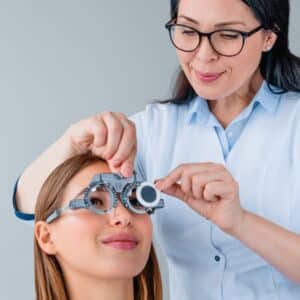Eye pain, medically known as ophthalmalgia, refers to discomfort or a distressing sensation within or around the eye. It is characterized by varying degrees of pain, ranging from mild irritation to severe, intense discomfort.
Eye pain can be localized to the eye’s surface or may originate deeper within the eye, and it can be caused by a wide range of factors, including eye injuries, infections, inflammation, underlying medical conditions, or foreign objects in the eye.
The nature and severity of eye pain can vary widely, often accompanied by other symptoms such as redness, tearing, vision changes, or light sensitivity. Timely evaluation by a healthcare professional or eye specialist is essential to determine the cause of eye pain and initiate appropriate treatment.
Ignoring persistent or severe eye pain can lead to complications and potential vision problems, emphasizing the importance of seeking medical attention when experiencing eye discomfort.
Identifying Where It Hurts
To effectively address eye pain and determine its underlying cause, it’s crucial to pinpoint the specific location within the eye where the discomfort originates. Understanding the structures involved and their functions can provide valuable insights into the source of your eye pain. Let’s explore these structures and how to identify where it hurts:
- Cornea: The cornea is the eye’s clear, dome-shaped front surface. Its primary function is to focus light onto the retina. If your eye pain is superficial and feels like a scratch, burning, or foreign object sensation, it may originate from the cornea.
- Sclera: The sclera, often referred to as the “white” of the eye, surrounds the cornea and provides structural support to the eye. Discomfort originating from the sclera may manifest as a diffuse, generalized pain that affects the entire eye.
- Conjunctiva: The conjunctiva is a thin, transparent membrane that covers the sclera and lines the inside of the eyelids. Irritation or inflammation of the conjunctiva can result in redness, itching, and a gritty sensation on the eye’s surface.
- Iris: The iris is the colored part of the eye with the pupil at its center. Pain related to the iris is less common but may be associated with conditions like iritis or uveitis. Symptoms often include deep-seated pain, pupil size changes, and light sensitivity.
- Orbit: The orbit refers to the bony eye socket within the skull that houses the eye and its muscles. If you experience deep, intense pain within the eye, it may originate from structures within the orbit. This type of pain can be associated with conditions like glaucoma or optic neuritis.
- Extraocular Muscles: The extraocular muscles are responsible for the movement and rotation of the eye. Discomfort related to these muscles may occur during eye movement and can indicate conditions affecting their function.
- Nerves are critical in transmitting visual information from the eye to the brain. Inflammation or damage to the optic nerve, known as optic neuritis, can lead to pain, particularly during lateral eye movements.
- Eyelids: The eyelids serve as protective coverings for the eye and help distribute moisture over the ocular surface. Pain associated with the eyelids may be linked to conditions like blepharitis or a sty (chalazion).
Recognizing the location of your eye pain and considering accompanying symptoms can provide valuable information to your healthcare provider or eye specialist. This information is essential for accurate diagnosis and developing an appropriate treatment plan. If you are uncertain about the source of your eye pain or if it is persistent and severe, seeking an eye doctor is strongly recommended to ensure your eye health and well-being.
Causes of Eye Pain
Eye pain can arise from various factors with unique characteristics and implications. Understanding the underlying causes of eye pain is crucial for accurate diagnosis and appropriate treatment. Here, we explore the common causes in more detail:
- Foreign Object: One of the most common causes of eye pain is the presence of foreign objects in the eye. These irritants can lead to discomfort, whether it’s an eyelash, a speck of dirt, or makeup particles. Symptoms often include redness, tearing, and a sensation of something in the eye.
- Conjunctivitis (Pink Eye): Conjunctivitis is the inflammation of the conjunctiva, the thin membrane covering the eye’s white part and the eyelids’ inner surface. It can result from allergies or infections, which may cause mild eye pain, itchiness, redness, and eye discharge.
- Contact Lens Irritation: Improper use and maintenance of contact lenses can lead to eye pain. Sleeping with lenses, failing to disinfect them properly, or wearing them for extended periods can result in irritation or infection, causing discomfort.
- Corneal Abrasion: A corneal abrasion refers to a scratch on the cornea, the eye’s clear front surface responsible for focusing light. This type of injury can occur for various reasons, such as accidental eye rubbing or exposure to foreign objects. Corneal abrasions often lead to a sensation of having something in the eye, pain, light sensitivity, and excessive tearing.
- Injury: Eye injuries, whether from physical trauma or exposure to chemical irritants, can cause significant pain. Chemical burns and flash burns to the eye, often resulting from exposure to substances like bleach or intense light sources, can lead to severe eye pain and require immediate attention.
- Blepharitis: Blepharitis occurs when the oil glands at the eyelids’ edge become infected or inflamed. This condition can cause eye pain and symptoms like redness, itching, and the sensation of foreign material in the eye.
- Sty: A sty, also known as a chalazion, can develop when an oil gland in the eyelid becomes infected or inflamed. While a chalazion typically isn’t painful, it can lead to a tender bump on the eyelid.
- Glaucoma: Glaucoma is a group of eye conditions characterized by increased intraocular pressure. It can lead to severe eye pain, especially during acute angle-closure glaucoma episodes. Other symptoms may include nausea, headache, and vision loss. Acute angle-closure glaucoma is a medical emergency that requires immediate treatment to prevent blindness.
- Optic Neuritis: Optic neuritis involves inflammation of the optic nerve, which connects the back of the eye to the brain. This condition can result in eye pain accompanied by vision loss, particularly during lateral eye movements. Optic neuritis can be associated with autoimmune diseases or infections.
- Sinusitis: Sinusitis, an infection of the sinuses, can exert pressure on the eyes, causing pain. Depending on the location of the sinus infection, the pain may be felt on one or both sides of the eyes.
- Migraines: Migraine headaches often include eye pain as a prominent symptom. Migraine-related eye pain can be intense and accompanied by other classic migraine symptoms like severe headache, nausea, and light sensitivity.
- Iritis: Iritis, or inflammation of the iris, can cause deep-seated eye pain. While relatively uncommon, it may be associated with systemic conditions, infections, or trauma.
- Understanding these diverse causes of eye pain is the first step in effectively addressing and managing this symptom. Treatment options vary depending on the cause, from home remedies to medical interventions. Timely evaluation by an eye care professional is essential for appropriate diagnosis and treatment planning.
Eye Pain Treatment
Eye pain treatment depends on the underlying cause and severity of the condition. Below are treatment options commonly employed to address various eye-related issues:
- Home Care:
- Artificial Tears: Lubricating eye drops can provide relief from dryness and irritation. They are particularly helpful for mild cases of eye discomfort.
- Rest: Resting your eyes, especially after prolonged screen time or eye strain, can alleviate mild eye discomfort.
- Medications:
- Antibiotic Eye Drops or Ointments: These are prescribed for bacterial eye infections such as bacterial conjunctivitis (pink eye) or bacterial keratitis (corneal infection).
- Antiviral Medications: Used to treat viral eye infections like herpes simplex keratitis.
- Antihistamines: Oral antihistamines or antihistamine eye drops can help relieve eye symptoms caused by allergies.
- Corticosteroids: These anti-inflammatory medications may be prescribed for conditions like iritis or uveitis.
- Warm Compress:
- Applying a warm, moist compress to the affected eye can benefit conditions like blepharitis or styes. It helps relieve discomfort and encourages the drainage of blocked glands.
- Flushing:
- If a foreign body or chemical substance enters the eye, flushing the eye with clean water or saline solution is essential to remove the irritant.
- Oral Medications:
- Sometimes, your healthcare provider may prescribe oral medications to address underlying causes, such as antibiotics for certain infections or pain medications to manage severe eye pain.
- Surgical Interventions:
- Surgery for Corneal Abrasions: In rare cases, surgical repair may be required for deep corneal abrasions that do not heal with conservative measures.
- Glaucoma Surgery: When medication and eye drops are insufficient to manage intraocular pressure, surgical procedures may be recommended to improve drainage and reduce pressure.
- Vision Correction:
- For some eye conditions, like refractive errors, vision correction methods such as glasses or contact lenses can significantly improve eye comfort and visual clarity.
- Specialized Treatments:
- Laser Therapy: Certain eye conditions, like glaucoma, may benefit from laser therapy to lower intraocular pressure and manage the disease.
- Injections: In the case of severe eye inflammation or macular degeneration, specialized injections into the eye may be recommended by an ophthalmologist.
- Management of Underlying Conditions:
- Treating underlying medical conditions that contribute to eye problems is essential. Conditions like diabetes, autoimmune diseases, and systemic infections may require comprehensive management.
The treatment choice depends on the specific diagnosis made by an eye care specialist. Self-diagnosis and treatment without professional guidance can be risky and may exacerbate the problem. If you experience persistent or severe eye pain, changes in vision, or any concerning eye symptoms, seek prompt evaluation by a healthcare provider or ophthalmologist. Timely and appropriate treatment can help alleviate discomfort, prevent complications, and preserve your eye health.
Eye Pain: Recognizing Emergency Situations
While many cases of eye pain can be managed with home care or standard medical treatment, there are situations in which eye pain constitutes a medical emergency. Prompt recognition of these emergency scenarios is critical to prevent potential vision loss or serious complications. Here are some eye-related emergencies to be aware of:
- Sudden Vision Loss: If you experience a sudden and dramatic vision loss in one or both eyes, it requires immediate medical attention. Sudden vision changes may indicate a severe underlying issue, such as retinal detachment, vascular occlusion, or acute glaucoma.
- Severe Eye Pain: Intense and unrelenting eye pain that is out of proportion to a minor injury or irritation is a cause for concern. This pain level may indicate conditions like acute glaucoma, severe corneal infection, or intraocular pressure spikes, all requiring immediate treatment.
- Eye Trauma: Any significant eye injury, whether from a foreign object, blunt force, or chemical exposure, should be considered an emergency. Avoid rubbing or applying pressure to the injured eye, and seek medical attention promptly.
- Chemical Exposure: Immediate action is crucial if your eye comes into contact with a chemical substance, such as household cleaners or industrial chemicals. Flush the affected eye with copious amounts of clean water or a saline solution for at least 15 minutes and seek emergency medical care.
- Abdominal Pain with Eye Symptoms: If you experience severe eye pain along with abdominal pain, nausea, and vomiting, it may be a sign of a systemic condition like acute angle-closure glaucoma. This condition requires immediate medical intervention.
- Pain Preventing Eye Touch: If the eye pain is so severe that you cannot touch or move your eye without significant discomfort, it should be considered an emergency. This pain level can indicate severe inflammation, infection, or other serious conditions.
- Light Halos and Rainbow-Colored Circles: Seeing halos or rainbow-colored circles around lights, especially if accompanied by severe eye pain, can indicate acute glaucoma and should be treated as an emergency.
- Foreign Body Embedded in the Eye: If a foreign object has penetrated the eye or become embedded in its surface, it is a medical emergency. Do not attempt to remove it yourself; instead, seek immediate professional help.
In any of these emergencies, seeking immediate medical attention from an eye care specialist or visiting the nearest emergency department is crucial. Do not delay seeking help; early intervention can prevent permanent vision loss and complications. Protecting your eyes and prioritizing their well-being is paramount in these critical moments.
Preventing Eye Pain: Protecting Your Vision
Taking proactive steps to prevent eye pain and maintain the health of your eyes is essential. Adopting good eye care habits and minimizing potential risks can reduce the likelihood of experiencing eye discomfort and related problems. Here are effective strategies for preventing eye pain:
- Wear Protective Eyewear:
- Use safety goggles or glasses when engaging in activities that could expose your eyes to flying debris, chemicals, or foreign objects. This includes activities like woodworking, sports, or working with hazardous materials.
- Practice Good Contact Lens Hygiene:
- If you wear contact lenses, follow your eye care professional’s proper hygiene, cleaning, and lens replacement recommendations. Only sleep in your lenses if they are specifically designed for extended wear.
- Limit Screen Time:
- Reduce digital eye strain by following the 20-20-20 rule: Every 20 minutes, take a 20-second break and look at something 20 feet away to reduce eye fatigue when using digital devices.
- Ensure Proper Lighting:
- Adequate lighting can help reduce eye strain. Avoid glare from windows or overhead lights when working on a computer or reading. Use task lighting to illuminate work areas.
- Blink Regularly:
- Blinking helps moisten the eyes and prevent dryness, especially when focusing on screens for extended periods. Make a conscious effort to blink more often.
- Use Artificial Tears:
- Lubricating eye drops, also known as artificial tears, can help relieve dryness and soothe irritated eyes. Consult with an eye care professional for guidance on the most suitable eye drops for your needs.
- Maintain a Healthy Diet:
- Nutrients like vitamins A, C, and E and omega-3 fatty acids benefit eye health. Incorporate foods rich in these nutrients, such as leafy greens, fish, and colorful fruits and vegetables, into your diet.
- Stay Hydrated:
- Proper hydration is essential for overall health, including eye health. Drinking an adequate amount of water can help prevent dry eyes.
- Protect Your Eyes from UV Radiation:
- Wear sunglasses that block 100% of UVA and UVB rays to protect your eyes from the harmful effects of ultraviolet (UV) radiation. UV exposure can increase the risk of cataracts and other eye conditions.
- Get Regular Eye Exams:
- Routine eye examinations by an optometrist or ophthalmologist are essential for maintaining good eye health. Regular check-ups can help detect and address potential problems early, even before symptoms arise.
- Manage Underlying Health Conditions:
- Conditions like diabetes and hypertension can affect your eyes. Manage these conditions effectively with medical guidance to reduce the risk of eye complications.
- Practice Eye Safety at Home:
- Be cautious when using household chemicals, power tools, or gardening equipment. Always read and follow safety instructions and use appropriate eye protection.
By incorporating these preventative measures into your daily routine and seeking professional eye care when needed, you can significantly reduce the risk of eye pain and maintain clear and comfortable vision. Remember that your eyes are a valuable and delicate asset, deserving of careful attention and protection.
Conclusion: Safeguarding Your Vision and Well-Being
Eye pain is a common but often treatable issue that can arise from various causes, ranging from minor irritations to more serious conditions. Understanding the sources of eye pain, recognizing potential emergencies, and knowing when to seek professional help are vital aspects of maintaining good eye health.
Timely diagnosis and treatment are essential for preserving your vision and preventing complications. Whether addressing common eye problems like conjunctivitis or managing more severe conditions like glaucoma, effective treatment options are available.
Preventing eye pain begins with adopting healthy eye care habits, such as wearing protective eyewear, taking breaks during screen time, and maintaining proper lighting conditions. A balanced diet rich in eye-friendly nutrients and regular eye exams are key to proactive eye care.
Your eyes are precious, and their well-being directly impacts your overall quality of life. Prioritizing eye health by following preventive measures and seeking prompt medical attention when necessary is an investment in your vision and long-term well-being. Doing so lets you enjoy a lifetime of clear, comfortable, and pain-free vision.






